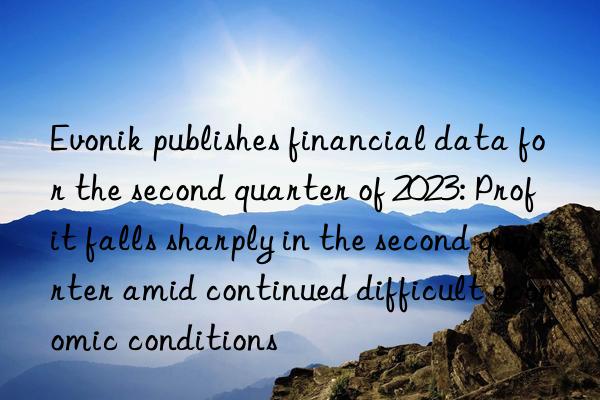
● Adjusted EBITDA of EUR 450 million in the second quarter, down 38% year-on-year
● Weak demand hampers recovery
● Cost control measures are progressing well
Evonik released its financial data for the second quarter of 2023, with adjusted earnings before interest, tax, depreciation and amortization (EBITDA) at 450 million euros, a slight improvement from the first quarter (409 million euros). Strict cost control measures boosted earnings. Adjusted EBITDA was down 38% compared to the same period last year. Previously, Evonik had released preliminary data for the second quarter on July 10.
Evonik Chairman Kullman said: "Germany and Europe are in recession, and China's economic recovery process is not as expected. Unfortunately, our business did not show a substantial improvement in the second quarter."
The economic downturn caused Evonik's second-quarter sales to fall 19 percent from a year earlier to 3.89 billion euros. Among them, sales volume fell by 9%, and selling price fell by 5%.
Evonik will implement a cost control plan from the second half of 2022 to ensure profitability. The group plans to achieve a cost reduction target of 250 million euros this year through measures such as not filling vacancies, reducing external services and travel. As of June 30, Evonik had achieved 40 percent of this goal.
Due to seasonal factors, free cash flow in the second quarter was -203 million euros, an improvement compared to -239 million euros in the same period in 2022. Evonik hopes to increase its cash conversion rate to around 40 percent this year (2022: 32 percent). However, as announced on July 10, the free cash flow target set earlier this year has been unable to achieve.
Chief Financial Officer Maike Schuh said: "We are working hard to ensure the company's cash flow. We will pool funds to ensure that the financial position can support the normal operation of the company."
Evonik expects capital expenditures of 850 million euros in 2023. The corresponding budget was cut from 975 million euros to 900 million euros earlier this year. All pending projects and further expenditures related to approved projects are subject to separate assessment. Evonik will continue to invest in green technologies, such as next-generation technologies that can save energy and reduce emissions, as well as spending on safety and maintenance.
Evonik posted a net loss of 270 million euros in the second quarter. This was mainly due to impairments of around EUR 390 million at global methionine production facilities and at silica production facilities located in Europe and North America.
Evonik is continuing to push forward with product portfolio adjustments. The German Ruerstorf base was transferred to the Luxembourg International Chemical Investor Group on June 30. Effective June 30, the super absorbent business has been classified as held for sale and reclassified on the balance sheet. The divestiture process is proceeding as planned.
Evonik does not expect the market to recover in the second half of 2023, and demand will remain sluggish. The Group announced on July 10 that after the annual adjustment EBITDA is expected to be revised down to between EUR 1.6 billion and EUR 1.8 billion. Previously, the expected range was 2.1 billion to 2.4 billion euros. Sales are expected to be between 14 billion and 16 billion euros.
Business Unit Performance
Specialty Additives: Second quarter sales fell by 19% year-on-year to EUR 906 million due to lower volumes and negative currency effects. In contrast, selling prices rose slightly due to higher raw material and energy costs. Last year's figure included sales from TAA's derivatives business, which was sold at the end of 2022. Demand for products used in the construction and coatings industries declined in all regions, leading to a sharp decline in sales. Sales of additives used in polyurethane foam and consumer durables also fell. Sales volumes of additives used in the automotive industry fell, but prices rose slightly. Adjusted EBITDA in the Specialty Additives segment fell by 24 percent to EUR 199 million, mainly due to lower volumes and lower capacity utilization. The adjusted EBITDA margin was 22.0%, still at a good level.
Nutrition & Consumer Chemicals: Second-quarter sales fell by 13% to EUR 893 million. Selling prices have dropped significantly, but sales have increased slightly. The sales of essential amino acids for animal nutrition rebounded, but the selling price dropped slightly again compared with the previous quarter, and was significantly lower than the level of the same period last year. Overall, sales of amino acid products have declined significantly. Overall sales of products used in the health and care industry were also down. Adjusted EBITDA in the Nutrition & Consumer Chemicals segment fell by 62 percent to EUR 71 million, mainly due to lower selling prices for essential amino acids. Adjusted EBITDA margin fell to 8.0 percent from 18.0 percent.
Smart Materials business unit: Second-quarter sales fell by 16% to EUR 1.12 billion due to a sharp decline in volumes. Selling prices remained stable and raw material costs fell slightly. Inorganic sales fell sharply due to lower demand in most market segments, but selling prices remained stable. Performance Polymers performed well due to higher volumes and selling prices. Adjusted EBITDA in the Smart Materials business unit fell by 44 percent to 122 million euros. The planned maintenance shutdown of the polyamide 12 (PA12) production unit also had a negative impact. Adjusted EBITDA margin fell to 10.9 percent from 16.4 percent.
Functional Materials: Second-quarter sales fell by 27% to EUR 694 million due to lower prices and volumes. The sales volume of carbon 4 products has decreased, and the selling price has dropped significantly. Sales of superabsorbents declined due to lower demand in the European market. Adjusted EBITDA in the Functional Materials segment fell by 68 percent to EUR 45 million. This was mainly due to the lower selling price of carbon 4 products, which offset the improvement in the superabsorbent business earnings. Adjusted EBITDA margin fell to 6.5 percent from 15.0 percent.



 微信扫一扫打赏
微信扫一扫打赏
